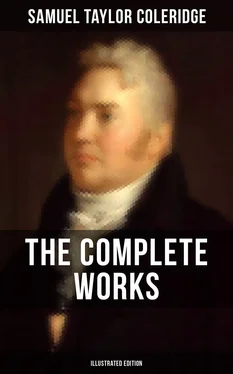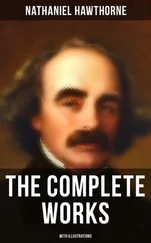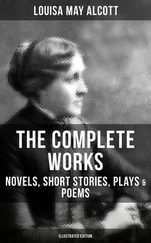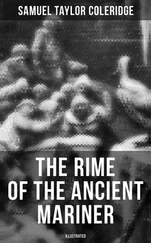The look, those shrunken serpent eyes, had made such a deep impression on Christabel,
That all her features were resign’d
To the sole image in her mind:
And passively did imitate
That look of dull and treacherous hate.
And thus she stood in dizzy trance,
Still picturing that look askance.
But when the trance was o’er, the maid
Paus’d awhile and inly pray’d,
”By my mother’s soul do I entreat
That thou this woman send away!”
She said, and more she could not say,
For what she knew she could not tell
O’er master’d by the mighty spell.
The poet now describes the Baron as suffering under the confused emotions of love for Christabel, and anger at her apparent jealousy, and the insult offered to the daughter of his friend, which so wrought upon him that,
He roll’d his eye with stern regard
Upon the gentle minstrel bard,
And said in tones abrupt, austere —
”Why, Bracy? dost thou loiter here?
”I bade thee hence!” The bard obey’d,
And turning from his own sweet maid,
The aged knight, Sir Leoline
Led forth the lady Geraldine!
Here ends the second canto.
In the conclusion to the second canto, he speaks of a child and its father’s fondness, so often expressed by “you little rogue,” “ you little rascal,” with an endearing kiss, says:
A little child, a limber elf,
Singing, dancing to itself;
A fairy thing with red round cheeks,
That always finds and never seeks;
Makes such a vision to the sight,
As fills a father’s eyes with light;
And pleasures flow in so thick and fast
Upon his heart, that he at last
Must needs express his love’s excess,
With words of unmeant bitterness.
The following relation was to have occupied a third and fourth canto, and to have closed the tale.
Over the mountains, the Bard, as directed by Sir Leoline, “hastes” with his disciple; but in consequence of one of those inundations supposed to be common to this country, the spot only where the castle once stood is discovered, — the edifice itself being washed away. He determines to return. Geraldine being acquainted with all that is passing, like the Weird Sisters in Macbeth, vanishes. Reappearing, however, she waits the return of the Bard, exciting in the mean time, by her wily arts, all the anger she could rouse in the Baron’s breast, as well as that jealousy of which he is described to have been susceptible. The old Bard and the youth at length arrive, and therefore she can no longer personate the character of Geraldine, the daughter of Lord Roland de Vaux, but changes her appearance to that of the accepted though absent lover of Christabel. Next ensues a courtship most distressing to Christabel, who feels — she knows not why — great disgust for her once favoured knight. This coldness is very painful to the Baron, who has no more conception than herself of the supernatural transformation. She at last yields to her father’s entreaties, and consents to approach the altar with this hated suitor. The real lover returning, enters at this moment, and produces the ring which she had once given him in sign of her betrothment. Thus defeated, the supernatural being Geraldine disappears. As predicted, the castle bell tolls, the mother’s voice is heard, and to the exceeding great joy of the parties, the rightful marriage takes place, after which follows a reconciliation and explanation between the father and daughter.
Lamb, who visited us soon after Coleridge’s death, and not long before his own, talking of the Christabel, observed, “I was very angry with Coleridge, when I first heard that he had written a second canto, and that he intended to finish it; but when I read the beautiful apostrophe to the two friends, it calmed me.” He was one of those who strongly recommended Coleridge to leave as a fragment what he had so beautifully begun. With the first edition of the Christabel was given Kubla Khan, the dream within a dream, written in harmonious and fluent rhythm. ‘The Pains of Sleep’ was also added. This is a poem communicating a portion of his personal sufferings. All these were published in 1816.
In the introduction to ‘The Lay of the last Minstrel’, 1830, Sir
Walter says,
“Were I ever to take the unbecoming freedom of censuring a man of Mr. Coleridge’s extraordinary talents, it would be on account of the caprice and indolence with which he has thrown from him, as in mere wantonness, those unfinished scraps of poetry, which, like the Tasso of antiquity, defied the skill of his poetical brethren to complete them. The charming fragments which the author abandons to their fate, are surely too valuable to be treated like the proofs of careless engravers, the sweepings of whose studies often make the fortune of some pains-taking collector. And in a note to the Abbot, alluding to Coleridge’s beautiful and tantalizing fragment of Christabel, he adds, Has not our own imaginative poet cause to fear that future ages will desire to summon him from his place of rest, as Milton longed
’To call up him who left half told
The story of Cambuscam bold.’”
Since writing the preceding pages, I have met with a critique on the Christabel, written immediately after it was published, from which I select a few passages, in the hope that they may further interest the admirers of this poem:
‘The publication of Christabel cannot be an indifferent circumstance to any true lover of poetry — it is a singular monument of genius, and we doubt whether the fragmental beauty that it now possesses can be advantageously exchanged for the wholeness of a finished narrative. In its present form it lays irresistible hold of the imagination. It interests even by what it leaves untold. — The story is like a dream of lovely forms, mixed with strange and indescribable terrors. The scene, the personages, are those of old romantic superstition; but we feel intimate with them, as if they were of our own day, and of our own neighbourhood. It is impossible not to suppose that we have known “sweet Christabel,” from the time when she was “a fairy thing, with red round cheeks,” till she had grown up, through all the engaging prettinesses of childhood, and the increasing charms of youth, to be the pure and dignified creature, which we find her at the opening of the poem. The scene is laid at midnight, in the yet leafless wood, a furlong from the castle-gate of the rich Baron Sir Leoline, whose daughter, “the lovely Lady Christabel,” has come, in consequence of a vow, to pray at the old oak tree, “for the weal of her lover that’s far away.” In the midst of her orisons she is suddenly alarmed by a moaning near her, which turns out to be the complaint of the Lady Geraldine, who relates, that she had been carried off by warriors, and brought to this wild wood, where they had left her with intent quickly to return. This story of Geraldine’s easily obtains credence from the unsuspecting Christabel, who conducts her secretly to a chamber in the castle. There the mild and beautiful Geraldine seems transformed in language and appearance to a sorceress, contending with the spirit of Christabel’s deceased mother for the mastery over her daughter; but Christabel’s lips are sealed by a spell. What she knows she cannot utter; and scarcely can she herself believe that she knows it.
On the return of morning, Geraldine, in all her pristine beauty, accompanies the innocent but perplexed Christabel to the presence of the Baron, who is delighted when he learns that she is the daughter of his once loved friend, Sir Roland de Vaux, of Tryermaine. — We shall not pursue the distress of Christabel, the mysterious warnings of Bracy the Bard, the assumed sorrow of Geraldine, or the indignation of Sir Leoline, at his daughter’s seemingly causeless jealousy — what we have principally to remark with respect to the tale is, that, wild and romantic and visionary as it is, it has a truth of its own, which seizes on and masters the imagination from the beginning to the end. The poet unveils with exquisite skill the finer ties of imagination and feeling by which they are linked to the human heart.
Читать дальше












